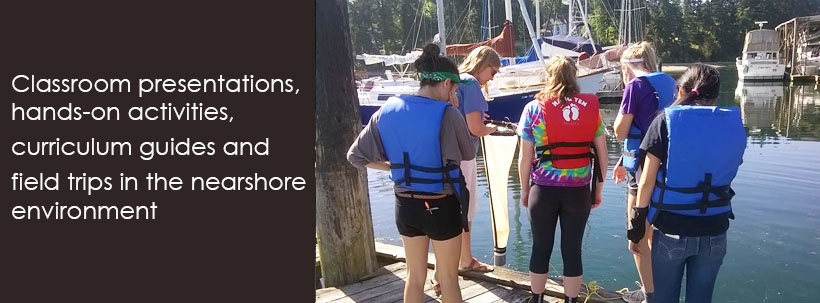Mission
Our mission is to provide the community with science-based, hands on learning opportunities related to shellfish, water quality and Puget Sound stewardship.
Vision
A community that is knowledgeable about local water quality issues and inspired to take every day actions to protect the health of Puget Sound
About
PSI staff are both scientists and informal educators. We conduct research here in South Puget Sound and enjoy sharing our locally relevant work with students. Thanks to generous funding from local Foundations, PSI is able to serve all students – free of charge – in Lewis, Mason, Thurston, Pierce, Grays Harbor and Pacific Counties. PSI is dedicated to inspiring students to become the next generation of scientists and stewards of our oceans and estuaries. We offer an array of classroom presentations and field trip opportunities that increase scientific literacy through hands-on activities, outdoor experiential investigations, engineering solutions, and action projects. PSI is happy to work with you to tailor presentations to meet your individual needs. Ask us!
Classroom Presentations
Career Connections
Field Trips
Ocean Plastics - Properties of Matter (ES, MS, HS)
Recently updated to support Properties of Matter MS science standards, this lesson focuses on the history, chemical composition and structure of plastics; origin, transport and destination of ocean plastics; impacts on the environment; solutions and stewardship. Activities include a Sink/Float Plastic Density investigation, Albatross Bolus dissection, and/or Recycle Right demonstration. Students can enrich their learning by participating in a debris cleanup on campus or at a nearby park. Teachers may request Field Investigation Notebooks that allow students to map their site, ask investigative questions, collect data, reflect and create action plans. Need cleanup supplies? You are welcome to borrow PSI's grabbers, tongs, gloves, buckets and data sheets.
ACTIVITY Plastic Density (MS)
ACTIVITY Plastic Density (ES) + Instructional Video
Trash Cleanup Field Investigative Notebook
PSI Trash BINGO Card
ICC Trash Data Form
INVESTIGATION Recycle Right
SOUND SCIENCE STEWARDS Sticker Program
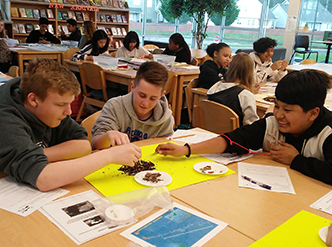
Middle school students rotate through the Albatross bolus dissection and Sink/Float plastic density investigation during PSI's Ocean Plastics - Properties of Matter presentation. |
Ocean Plastics is one of PSI most requested presentations. Content focuses on current science, engineering solutions, and personal actions. The classroom component is often coupled with a trash cleanup on-campus or at a nearby park.
|
Ocean Acidification - Acids, Bases & Shell Building Races (MS) Coastal Acidification (MS/HS)
Since the Industrial Revolution, the amount of carbon dioxide in the atmosphere has dramatically increased. Approximately 25% of this carbon dioxide is absorbed into the world’s oceans changing its chemistry in a process called ocean acidification. Join PSI biologists as they break down the complexities of ocean acidification. Act out changes in ocean chemistry that can leave oysters racing to snatch up valuable shell building components. Play the pH guessing game, change water pH with dry ice, and test what happens to shells in an acidic environment. Become empowered as we brainstorm ways to address this important issue and then commit to taking positive actions to do so.
The Coastal Acidification unit covers basic OA in addition to other factors that drive local pH changes including upwelling, salinity & phytoplankton.
ACTIVITY OA Properties of Matter (upper ES)
ACTIVITY OA Cabbage Juice (ES)
INVESTIGATION Coastal Acidification (MS/HS)
INVESTIGATION Car Idling Survey
Learn More
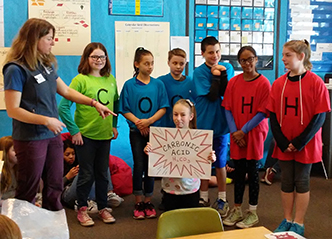
Students grasp the chemistry behind ocean acidification by morphing into molecules in this interactive skit! |
This program was developed to break down the complexities of ocean acidification in an interactive, fun way. The play has been performed by students, teachers and shellfish growers alike. Learn about the science and solutions surrounding this important issue. |
Eutrophi...what? Nutrients in Budd Inlet (ES, MS, HS)
Eutrophication has been identified as one of the most serious threats to coastal environments worldwide. Learn how this process impacts Budd Inlet and what actions and engineering solutions are underway to reduce nutrient pollution in Puget Sound. Activities include performing a mussel filtration demonstration, acting out the process of eutrophication, viewing live plankton under microscopes, handling water quality equipment and learning about local efforts to address this issue.
Learn More
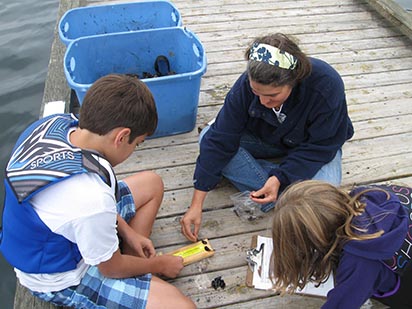
Volunteers collect mussel growth data in Budd Inlet during PSI's Nutrient Bioextraction research project. |
PSI led a nutrient bioextraction research project in Budd Inlet for 4 years. Invite PSI into your classroom to learn about this project, the nutrient cycle, why nutrient pollution is a problem locally, and what actions can be taken to address this issue. |
Stormwater - Keeping it Clean (ES)
Learn how stormwater impacts water quality, shellfish and other Puget Sound marine life. Using local case studies from Henderson Inlet, Long Lake and Budd Inlet, students learn about sources and impacts of bacteria and nutrient pollution. Then, become empowered as we highlight engineering solutions and actions we can take to improve water quality! Activities involve conducting mussel feeding and soil infiltration demonstrations, acting out the process of eutrophication, modeling proper scooping technique and viewing plankton under microscopes.
Bacteria Poo-lution in South Puget Sound (ES/MS)
This program is offered as a 2-Part series. In Part 1 (20-minutes), PSI introduces students to fecal bacteria pollution and provides an overview of the Field Investigation survey. In Part 2 (50-minutes), students walk to a nearby park where they use Field Investigation notebooks to map their survey location, flag, tally and scoop dog poop piles. After the survey, an Engineering Technician will talk with students about storm drains, open a catch basin and collect a stormwater sample. If time allows, PSI will help students test the sample for fecal coliform bacteria.
Pet Waste Field Investigation Notebook
Learn More
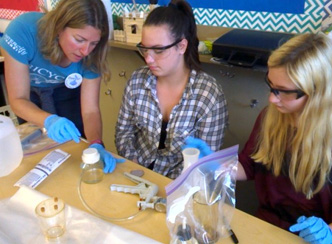
Middle school students monitor storm water samples for fecal coliform bacteria with PSI biologist, Aimee Christy. |
After a decade of outreach related to pet waste and bacterial contamination, Thurston County residents understand that picking up after dogs is critical for protecting water quality and human health, too. "Scoop It, Bag it, Trash it!" has become a social norm along Puget Sound. |
Oyster Anatomy (ES)
In this lesson, students learn about the body parts of an oyster and how those body parts help the animal survive. In groups of 3, students sketch, label and dissect a Pacific oyster.
ACTIVITY Oyster Anatomy Puzzle (and Instructional Video)

Students in Mason County sketch and label the parts of an oyster from the shell and mantle all the way to the anal pore. |
Students learn the parts of an oyster, how those parts help the animal survive and how each is similar or different to their own. Once the internal anatomy is labeled, students may carefully dissect their oysters. Extra bonus: learn the body parts in Spanish starting with la concha. |
Garden of the Salish Sea (ES/MS)
Garden of the Salish Sea Curriculum (GSSC) is an interdisciplinary K-12 environmental science pilot program that was created in 2012 in north Puget Sound. Using shellfish as a vehicle to teach pollution prevention and science, students are inspired to practice watershed healthy habits engaging the participation of their families and communities with the Salish Sea Challenge. Learning through field inquiry, experiments, hands-on activities, games and artwork, students are motivated to pursue conservation and science. GSSC is focused on local tidelands and the marine environment with a concentration on ocean acidification. GSSC is funded through Whatcom Community Foundation and Alcoa Foundation grants.
Learn More
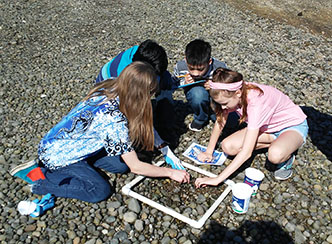
Middle school students perform intertidal transects during the 4-week long Garden of the Salish Sea Curriculum. |
This program was initiated in 2012 by Julie Hirsch to students in Whatcom County. In 2017, PSI expanded the reach of this program to South Puget Sound schools, offering the 4-wk curriculum to students at Roosevelt Elementary and Jefferson Middle School. |
Career Connections
Careers in Marine Biology (MS/HS)
In this career-focused presentation, 2 PSI biologists will share their career paths, highlight favorite research projects, offer career advice, and answer students’ questions. Student opportunities such as internships and science fair financial assistance will also be discussed. Activities include handling field equipment, identifying plankton under microscopes, learning common shellfish species and bowline knot tying. Presentation can be delivered in the classroom or outdoors.
PSI Staff Career Profiles
Learn More
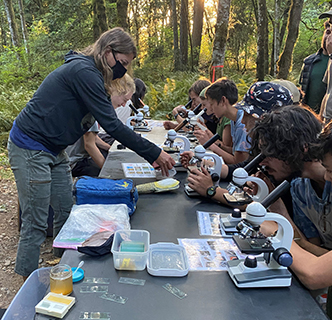
Northwest Youth Corps students learn about careers related to shellfish and water quality at Capitol Land Trust's Inspiring Kids Preserve. |
One of PSI's main educational goals is to inspire and motivate the next generation of marine scientists and stewards. As research scientists ourselves, we enjoy sharing information about our career paths, job skills, and favorite research projects. |
Shellfish Population Surveys - Managing Tasty Clams! (MS/HS)
Learn about local shellfish jobs, conduct a shellfish population survey, and exercise math skills in this career-related presentation. How do tribes, biologists and resource managers conduct shellfish population surveys and why are they important? Turn your classroom or school yard into a beach as we act out the players, identify shellfish species, conduct a shellfish population survey, calculate total allowable catch & divvy up our tasty rewards (in Swedish Fish).
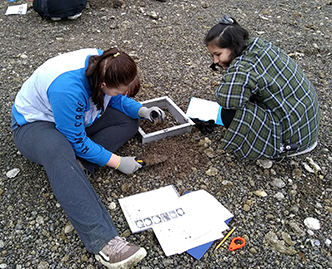
Students perform a shellfish population survey at Twanoh State Park, Mason County. |
For students interested in a career in marine biology, this presentation offers many practical skills. Population surveys are conducted for numerous types of marine invertebrates. After this presentations, students will have another valuable skill to add to their resumes!
|
Tiny Crabs, Big Impacts: Long-Term Monitoring for Healthy Dungeness Populations – MS
Fishing pressure and impacts of climate change are among the drivers implicated in recent Dungeness crab recruitment failures and smaller adult populations. PSI biologists are collaboratively monitoring larval crab populations in South Sound, April - Sept as part of the Pacific Northwest Crab Research Group. This new curriculum was designed for students to engage with ongoing research in Puget Sound. In this lesson, students will learn how regional scientists are monitoring larval Dungeness crab using light traps. Students graph and analyze data, and think critically about solutions to a current natural resource issue.
Learn More

Biologists from the Nisqually Tribe, PSI, and DNR check the light trap at Zittels Marina. Photo: Debbie Preston (NWIFC) |
Data collected by the Pacific Northwest Crab Research Group's regional light trap study helps crab fishery biologists make decisions about how adult populations of Dungeness crab should be sustainably managed year to year.
|
SoundToxins - Phytoplankton Monitoring Program (all grades)
PSI has monitored Budd Inlet plankton for over a decade as part of NOAA’s SoundToxins program. In this lesson, students learn about the microscopic world of plankton, harmful algal blooms (HABs), and how SoundToxins protects human health. MS/HS students analyze Budd Inlet data to predict when Diarrhetic Shellfish Poisoning closures are most likely to occur and which species may be responsible. Activities include viewing live plankton under microscopes and handling water quality equipment.
INVESTIGATION What's Blooming in Budd? (ES)
INVESTIGATION SoundToxins (MS/HS)
INVESTIGATION SoundToxins (MS/HS) - KEY
INVESTIGATION SoundToxins Excel Data
Learn More

High School student, Shriya, collecting a SoundToxins plankton sample in Budd Inlet.
|
PSI has sampled plankton in Budd Inlet for over a decade as part of StreamTeam's What's Blooming in Budd? program. Samples are screened for harmful algal blooms and entered into the SoundToxins database. The data have proven to be so valuable that PSI now collects samples year-round.
|
Field Trips
Olympia Waterfront Tour (upper ES/MS)
In this 2-hour tour, students learn about Puget Sound – right in their own backyard! The tour begins at Port Plaza where students rotate through stations: 1) Water Quality Equipment and Sampling; 2) Plankton and Harmful Algal Bloom Monitoring; and 3) Tower Trivia! Students proceed on a shoreline tour to Capitol Lake discussing topics such as King tides and sea level rise, Budd Inlet history, the Lake/Estuary debate, and invasive species such as the New Zealand mud snail. If the timing is right, students will even get to pass through Percival Fountain (weather and teacher permitting, of course).
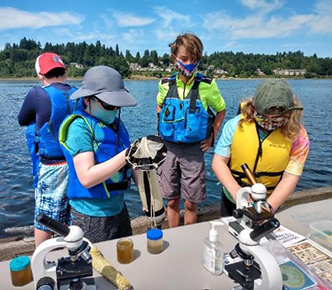
Students collect water quality data and plankton samples during one of several stops along the Olympia Waterfront Tour. |
Every resident of Thurston County should have the pleasure of learning about the fascinating history of Budd Inlet. This tour connects students to their local watershed and introduces them to local issues that the community is currently facing. |
Beach Field Trips - Invite Us Along!
Invite PSI to host or co-host your next field trip! PSI will facilitate investigative stations that might include 1) Water Quality Equipment and Plankton Identification; 2) Beach BioBlitz and Shellfish Identification; 3) Shellfish Population Surveys; and/or 4) Beach Stewardship. Can’t get to the beach? We can also perform these same activities in your classroom, school yard or as part of a walking field trip to a nearby park, lake, or stream. Ask us how.
Check out our School Yard or Neighborhood Bioblitz and Instructional Video
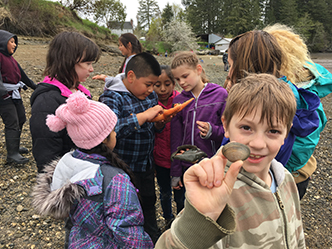
Students conduct an intertidal beach Bioblitz at Little Skookum Shellfish Farm. |
Learning comes naturally when kids are outdoors on the beach. PSI activities provide both structure and the freedom to explore. Contact us to see how we can design a beach field trip that works for your students. |
| |
Students from Roosevelt Elementary learn about shellfish gardening and ecosystem services (top) as part of the Garden of the Salish Sea Curriculum and Mason County students learn about beach ecosystems during a scavenger hunt at Twanoh State Park (below).
Mary Elizabeth Bissell, Outreach & Education Manager
Aimee Christy, Research Biologist & Educator
Katie Houle, Research Biologist & Educator
Find PSI and other great environmental educators and organizations at the Thurston Eco Network!
FUNDING SOURCES:
The Russell Family Foundation
Rose Foundation
Dawkin's Charitable Trust
|
| |
|






